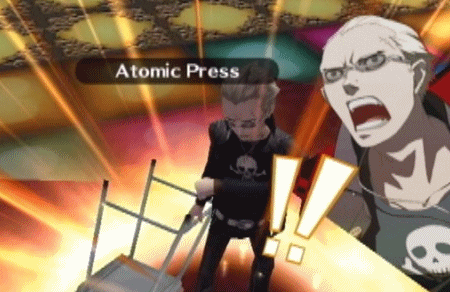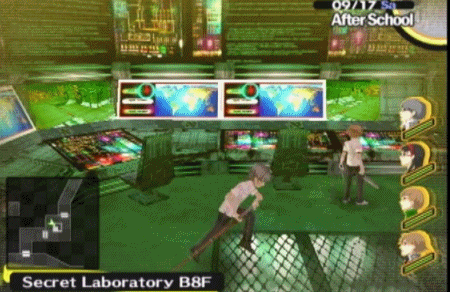 Review: Shin Megami Tensei: Persona 4
Review: Shin Megami Tensei: Persona 4

J-RPG
“Persona 4‘s gameplay melds traditional console role-playing and dating simulation elements” – LOL!
![]()
Gareth
About a year ago I reviewed Persona 3 for PEOWW, an excellent JRPG (9/10) and just what we’ve come to expect from Atlus in regards to its Shin Megami Tensei (SMT) series and its spin-offs. Now we have the fourth in the Persona series, still on the PS2, and if you enjoyed P3 there is no reason for you not to have picked this up already. For those that haven’t played any SMT games I’ll be as informative as possible.

Ageing emo alert!
On the face of it Persona 4’s story seems very much the same as 3’s. You play as a new kid in town who quickly befriends a few fellow pupils and they get drawn into a world of fighting shadows. However P4’s story is far more interesting, and the first couple of hours of gameplay are actually used to slowly build the story, next to no combat actually happens.Murders have started taking place in the rural town you’ve moved to, at the same time a rumour is going around school that if you stare into a switched off TV at midnight when it’s raining then you’ll tune into the Midnight Channel and see your soul mate. It quickly becomes apparent that the people appearing on the Midnight Channel and those being murdered are one and the same, but no one but your gang seems to have noticed so it’s down to you to stop it.
Your character accidentally realises he can enter the TV, and so you and your friends enter the world to discover that it’s like a spooky film set, where people’s hidden feelings come to the fore and shape the world. You quickly get attacked and your character learns he has the ability to summon Personas (demon like creatures, many of which you’ll recognise from other SMT games), and much like in the first game, the main character can summon many different Personas, whereas your party members only have one.

Why you should never let kids in your secret lab.
Again you have a year in game time to reach P4’s conclusion, broken up into one month chunks, and again you have to balance your real life with your adventures in the shadow world. You’ll have to go to school six days a week (bar holidays) and take exams, and socialise as well as a few new things. You can now take jobs, which will get you money and other bonuses as well (Courage, Knowledge, Diligence, Understanding, Expression). These bonuses will help you perform in exams or other activities. It also allows you to say different things during conversations, which will help strengthen your friendships faster.
Friendships, or Social Links, are important for creating new Personas for the main character. Fusing two or three Persona will create a new one, and if you have a strong friendship with someone related to the same species of Persona as the one you are making then it will receive an experience bonus and be more powerful. If you’ve played P3 you’ll be right at home with this feature, and if not, it may seem confusing but when you see it in action it’s actually quite simple, but versatile.
|
Gecks Secondary Review High school. That pivotal time where lifelong friendships are made, true love is found and the value systems that govern the rest of your life are formed. It’s a shame, then, that we all spend it being complete pricks, whilst our bodies exacerbate matters by making us as unattractive as possible. Fortunately you can – via Atlus’s Persona series – vicariously live through a year of a Japanese student’s life, chatting-up girls by day and fighting monsters by night – two things I did very little of in my teens. You might baulk at the prohibitively ‘anime’ nature of the presentation and dialogue, but it quickly becomes part of its unique charm. Likeable characters, an endurable amount of melodrama, no random encounters, and a battle system that has you looking for fights, rather than avoiding them; Atlus have again provided an experience that shames the next generation’s compliment of RPGs. The most significant improvement from its predecessor is the better integration of the dungeon crawling into the rest of the story, with each TV world representing character’s internal conflicts, rather than the ‘because it’s there’ scary tower of P3. It is certainly true that I would have enjoyed this more had I not played the previous game to death, but whilst this treads much the same path, there have been enough subtle improvements, and another collection of likeable characters to make it as compelling as ever. As for those who have yet to experience the series: here’s your future. Secondary Score: 9/10 |
So far so similar to P3, but a major change to the gameplay of P3 is that you no longer get tired whilst in the dungeons. In P3 once you got tired it would greatly affect your battles and what you’d be able to do the next day, which is not the case in P4. As long as you have enough HP/SP to continue you can stay in the dungeon, and later on you gain the ability to pay for healing, which basically means you can stay in the dungeon as long as you want, once you return to the real world you will go straight to bed though, and won’t be able to do any evening activities.
In a way this is quite liberating as the time limit is no longer so much of a factor, but when you were effectively forced to leave the shadow world or risk getting killed in P3 it kept the game moving at a nice pace, whereas I’ve found my prolonged stays in the dungeons of P4 to become a little tedious, though I could have left whenever I wanted.
The dungeons themselves are quite different this time around aswell. Whereas in P3 you were climbing the same tower throughout the entire game, here there are many different dungeons, each with their own themes. The variety is very welcome, although all dungeons are still randomly generated. The battles are initiated by attacking or being attacked by shadows as you explore. They are still turn based but unlike P3 you can control each character’s actions, not just the main character. You can leave them to their own devices if you please as the computer does a good job, but the option is a nice one.
Visually, as you’d expect from the PS2, it’s not stunning but has very strong presentation. There is a style throughout that is missing from a lot of ‘photorealistic’ games, the 2D character portraits are excellent and the anime sequences although not perfect put next-gen efforts such as Street Fighter 4’s to shame. The voice acting is strong yet again (English only), the characters although not incredibly original are interesting, and the music, though not as catchy as P3’s, is still pleasingly upbeat and J-poppy.
There have been quite a few small changes in Persona 4 and most are welcome. If you enjoyed Persona 3 then this is generally more of the same, and by that I mean a very, very good JRPG. For those who haven’t tried Persona 3 (or the re-release, P3: FES) who still enjoy their PS2 gaming then this is worth a look. As with all SMT games it’s challenging, but the Persona series is a little more accessible for those who may not have tried a JRPG before. I look forward to when Atlus make the SMT jump to next-gen, as the presentation on this PS2 effort is something I’m finding quite rare at the moment.
Rating: 








 9/10
9/10
